Introduction to Hanfu
Hanfu, the traditional clothing of the Han Chinese, has been a significant part of China’s cultural heritage. This attire, known for its elegance and historical value, symbolizes more than just fashion. It reflects the deep-seated philosophies, ethics, and social ideals of ancient China.
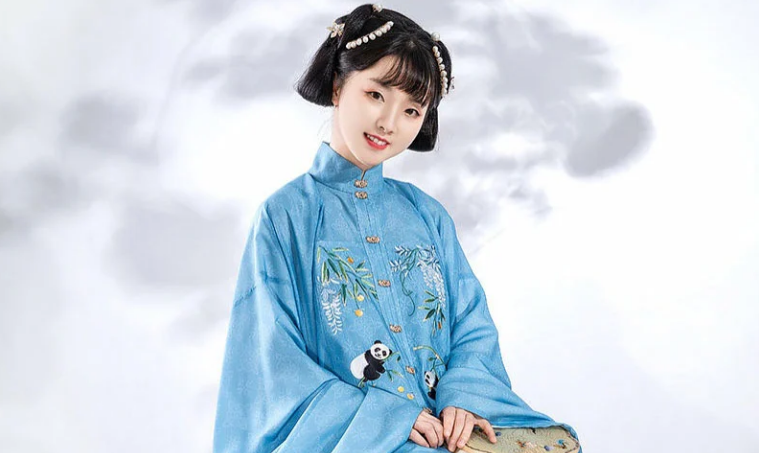
Defining Hanfu: Style and History
Evolution Over Time
Hanfu has undergone various transformations throughout China’s dynastic periods. Starting from the Shang Dynasty, Hanfu evolved in style, material, and design, mirroring societal changes. The Tang Dynasty, often considered a golden age of Chinese culture, introduced flamboyant styles and broader silhouettes in Hanfu, influenced by multicultural exchanges.
Distinctive Features
Typical Hanfu features include cross-collars, flowing robes, wide sleeves, and sashes used to secure the garment instead of buttons. The Hanfu materials ranged from silk to linen, reflecting the wearer’s status and the climate. The designs often incorporated various motifs like dragons, phoenixes, and floral patterns, each symbolizing different virtues or societal roles.
Symbolic Colors and Patterns
Colors in Hanfu weren’t merely aesthetic choices but carried profound meanings. Red, representing happiness and good fortune, was commonly used in wedding Hanfu. Blue and green reflected the harmony of nature, while yellow, often reserved for the emperor, symbolized imperial power.
Influence of Confucianism
Confucian principles heavily influenced Hanfu. The emphasis on modesty and ritual propriety was evident in the conservative designs. Hanfu’s simplicity and elegance were seen as reflections of the Confucian ideal of grace and moral rectitude.
Role and Significance
Cultural Identity
Hanfu is more than clothing; it’s a key part of Chinese cultural identity. Its resurgence in modern times, especially among younger generations, reflects a growing interest in traditional values and a sense of national pride. This resurgence isn’t just a fashion trend but a movement, with enthusiasts aiming to revive and preserve this important aspect of Chinese heritage.
Hanfu in Modern Times
In contemporary society, Hanfu isn’t just historical reenactment. It’s adapted to modern fashion, with designers incorporating traditional motifs and styles into everyday wear. Events like Hanfu parades and festivals are becoming increasingly popular, showcasing the timeless appeal and cultural richness of this ancient attire.
In conclusion, Hanfu’s beauty lies not only in its aesthetic appeal but also in its ability to connect the past with the present, offering insights into China’s rich history and cultural values.
Cultural Significance of Hanfu
Hanfu, more than just traditional Chinese attire, encapsulates the rich tapestry of Chinese culture and history. This clothing style serves as a living symbol of the Chinese civilization’s ethos and artistic expression.
Symbolism in Design and Color
Communicating Status and Virtue
Each element in Hanfu, from colors to patterns, communicates specific messages. Imperial yellow, found exclusively in the emperor’s attire, signifies power and centrality in Chinese culture, as seen in historical records and artifacts. The use of blue and black, often associated with xuan colors in the Yin Yang philosophy, depicts the ideals of harmony and balance.
Meaningful Motifs
Traditional motifs in Hanfu, such as the dragon, phoenix, and lotus, are not just decorative. They convey blessings, good fortune, and purity. These designs derive from age-old folklore and mythologies, deeply embedded in the Chinese psyche.
Representing Ethical and Moral Ideals
Confucian Influence
Confucianism, with its focus on morality, righteousness, and proper conduct, significantly shaped Hanfu’s aesthetics. The dress’s modesty and simplicity reflect Confucian virtues like humility and respectability. For instance, the right-over-left lapel design is not just a style choice but symbolizes the proper order of nature and society, a core Confucian concept.
A Medium of Cultural Expression
Beyond fashion, Hanfu allows wearers to express their cultural identities and reconnect with their ancestral heritage. Particularly among the youth and during traditional festivals, it fosters a sense of belonging and continuity with the past. The Hanfu movement vividly demonstrates this, highlighting how traditional clothing can embody national pride and cultural renaissance.
Hanfu, in essence, weaves a narrative that extends far beyond its fabric. It encapsulates centuries of philosophical thought, social structure, and artistic expression, making it a profound symbol of Chinese culture and identity.
Hanfu in the Social Structure
Hanfu isn’t just clothing but a reflection of the intricate social hierarchy and values of ancient Chinese society. The styles, fabric, and even the colors of Hanfu could indicate a person’s social status, profession, and ethical alignment, playing a pivotal role in social interactions and organization.
Clothing as a Marker of Social Status
Indicating Rank and Class
In traditional Chinese society, the design and quality of Hanfu were direct indicators of a person’s social rank. For instance, the dragon robe with its distinctive nine dragons was reserved exclusively for the emperor, symbolizing supreme power and authority. The use of gold thread and fine silk in these robes further emphasized the emperor’s unparalleled status.
Variations Across Classes
Officials and scholars typically wore robes that were finer and more elaborately decorated than those of common people. This distinction in quality and decoration underlined the hierarchical nature of society. Common people generally wore simpler Hanfu, often made from cheaper, more durable materials like cotton or hemp, as detailed in historical texts and Hanfu records.
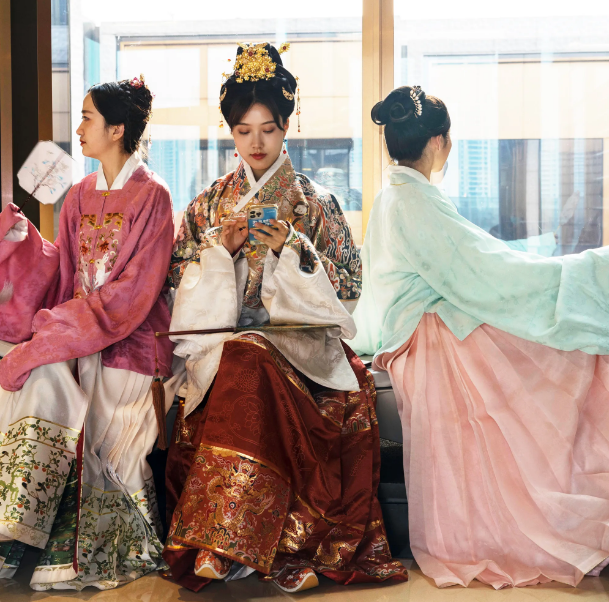
Hanfu in Various Social Ceremonies and Rituals
Weddings and Celebrations
Hanfu played a crucial role in weddings, where brides and grooms wore specific styles and colors, usually red, to symbolize joy and fortune. These garments were often embroidered with symbols like the double happiness character or dragon and phoenix motifs, representing a harmonious marriage.
Funerary Rites and Mourning
During funerary rites and periods of mourning, the bereaved would wear plain, unembellished Hanfu, often in white, to express their grief and respect for the deceased. This practice, deeply rooted in Confucian teachings on filial piety and respect for ancestors, is documented in various classical texts.
In summary, Hanfu is more than just a piece of traditional clothing. It represents a complex system of cultural codes and social norms. From indicating one’s place in the social hierarchy to playing a central role in key life events, Hanfu has been an integral part of Chinese culture, embodying the values and beliefs of a civilization spanning thousands of years.
Political Reasons for Wearing Hanfu
The choice of Hanfu and its style throughout Chinese history wasn’t only a matter of fashion or cultural preference but also a reflection of the political climate and governance ideologies. The ruling dynasty’s policies and philosophic inclinations heavily influenced Hanfu’s evolution and its societal role.
Hanfu During Different Dynasties
Changing Styles Reflecting Dynastic Shifts
Each Chinese dynasty brought its unique style to Hanfu, often to distinguish itself from its predecessors and to manifest its philosophical and political ideologies. For instance, the Han Dynasty favored Confucian orthodoxy, reflecting in the modest and straightforward styles of Hanfu. In contrast, the Tang Dynasty, known for its openness and inclusiveness, saw more elaborate and diverse Hanfu styles, incorporating influences from along the Silk Road.
Imperial Decrees and Fashion Trends
Emperors often used Hanfu to assert their authority and promote their state philosophy. The Ming Dynasty reinstated Hanfu styles of the Han Dynasty, emphasizing a return to ethnic Han culture after the foreign-ruled Yuan Dynasty. Such political statements, made through clothing, played a crucial role in consolidating power and cultural identity.
Clothing Edicts and Their Social Impacts
Laws Governing Dress
Clothing edicts were a common tool for emperors to enforce conformity and social order. These edicts could dictate everything from the colors that different social classes could wear to the length and type of garments. Violating these edicts was often seen as a challenge to imperial authority and could be met with severe penalties.
Enforcing Social Norms
Hanfu edicts served not only as political tools but also as means to reinforce social norms and moral values. For example, the Confucian emphasis on hierarchy and filial piety was mirrored in the protocols for dressing, including specific Hanfu types for certain ceremonies and social functions. This link between clothing and morality helped stabilize the social order by visually embedding social ranks and values into everyday life.
Through these aspects, Hanfu was much more than mere attire. It was a key element in the political and social engineering of imperial China, serving as a visible symbol of order, authority, and the prevailing philosophical doctrines of the time.
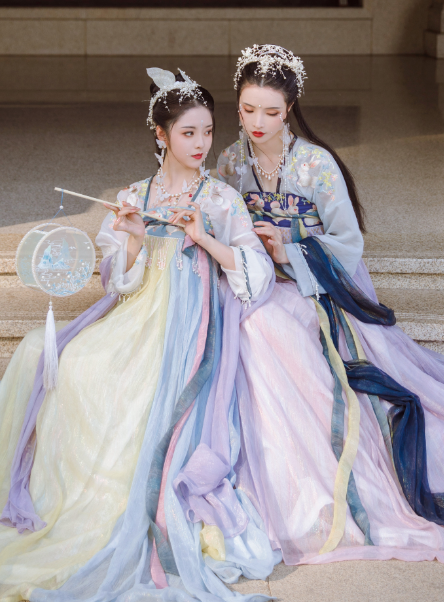
Hanfu and Philosophical Influences
Hanfu, as a traditional Chinese attire, has been profoundly influenced by the philosophical underpinnings of Chinese culture. The Confucian ethos, Taoist principles, and Buddhist thoughts have all played roles in shaping its style, symbolism, and societal perceptions.
Confucianism and its Impact on Attire
Modesty and Hierarchy
Confucianism, with its emphasis on ritual propriety, social hierarchy, and moral decency, greatly influenced Hanfu’s design. Confucian ideals advocated for modesty in dress, which was evident in the simple yet elegant styles of Hanfu. The attire was supposed to reflect a person’s social status and moral character, aligning with the Confucian virtue of “yi” (righteousness).
Color and Symbolism
In Confucian thought, colors had significant meanings and were chosen according to various factors including age, season, and social rank. The use of various colors in Hanfu was not arbitrary but deeply tied to these Confucian principles. For example, young people were encouraged to wear light and soft colors, reflecting their purity and simplicity, a concept widely discussed in Confucian literature.
Other Philosophical Perspectives Affecting Hanfu
Taoism and Naturalism
Taoist philosophy, with its principles of naturalism and simplicity, also left its mark on Hanfu. This influence is particularly noticeable in the flowing lines and loose fit of the garments, aiming to harmonize the human body with the natural world. Taoist priests often wore simple, unadorned Hanfu in their rituals, mirroring their pursuit of a simple, unencumbered life, a principle extensively explored in Taoist texts.
Buddhist Monastic Garments
Buddhism, though originally foreign, had a significant impact on Chinese culture, including clothing. Monastic robes, adapted from traditional Hanfu, were simplified and carried symbolic meanings, such as the representation of detachment from material life and the pursuit of spiritual enlightenment. These adaptations were not just limited to monastic circles but influenced lay fashion to some extent.
The rich tapestry of Chinese philosophy, encompassing Confucianism, Taoism, and Buddhism, offers a multifaceted understanding of Hanfu. These philosophies provided more than just aesthetic guidelines; they imbued Hanfu with deep cultural and ethical significance, making it a key element in the expression of Chinese identity and worldview.
Hanfu in Daily Life and Festivals
Hanfu, more than just a traditional Chinese attire, embodies a cultural ethos, deeply interwoven into the daily lives and festive occasions of Chinese people. Its use in daily wear and special events like festivals showcases the versatility and enduring legacy of this garment.
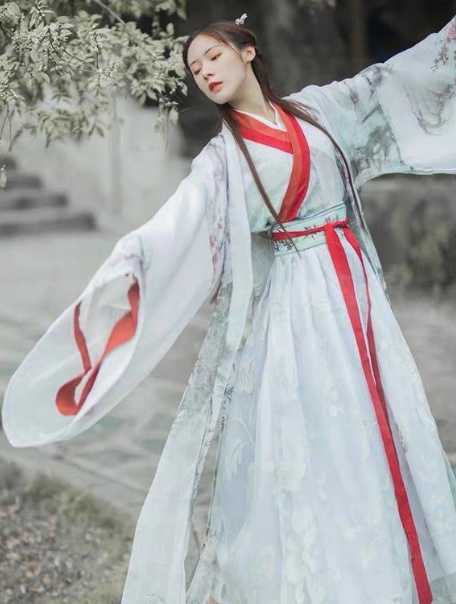
Everyday Wear vs. Festival Clothing
Practicality in Daily Wear
For daily wear, Hanfu tends to be more practical and comfortable. Historically, people chose fabrics like cotton and linen for their breathability and ease of movement. The designs were simpler, focused on functionality rather than ornateness. Daily Hanfu typically consisted of a Yi (a long tunic), a Chang (long skirt), and sometimes a Bixi (a long cloth panel hanging from the waist), ensuring comfort in everyday activities.
Elegance in Festival Attire
During festivals, Hanfu transformed into something more ornate and symbolic. People often wore Hanfu made from finer materials like silk and brocade, decorated with intricate embroidery that often carried specific meanings, like wishes for prosperity or happiness. Festive Hanfu was more colorful, incorporating vibrant patterns and symbolic designs, which set the attire apart from the more muted tones of everyday wear.
Seasonal Variations and Adaptations
Adapting to Seasons
Hanfu varied significantly with the seasons, both in material and style. In the sweltering summers, light silk Hanfu in lighter colors became popular for its ability to keep cool and wick away sweat. Conversely, in the bitter cold of winter, Hanfu made from heavier, warmer materials like wool or padded cotton was common. These seasonal adaptations were not only practical but also reflected the deep Chinese philosophical belief in harmonizing with nature’s rhythms.
Layering and Style Changes
To adapt to varying temperatures, layering became an essential aspect of Hanfu. During colder months, people would layer multiple garments, starting with thinner undergarments and adding thicker, more insulated pieces on top. This layering technique ensured both warmth and elegance. Similarly, the style and cut of Hanfu could change with the seasons; for example, wider sleeves and looser fits were preferred in summer for better ventilation.
Hanfu in daily life and festivals vividly illustrates the adaptability and enduring charm of this traditional Chinese attire. Far from being a static costume, Hanfu evolved with changing times and seasons, encapsulating the harmony between human and nature, practicality and beauty, tradition and innovation in Chinese culture.
Revival and Contemporary Significance
The resurgence of Hanfu in modern times is not just a fashion trend but a movement rich in cultural, social, and identity significance. The revival reflects a growing interest in traditional Chinese culture among the younger generations and symbolizes a deeper exploration and affirmation of Chinese identity.
Reasons Behind the Modern Hanfu Movement
Cultural Renaissance
One of the main reasons for the Hanfu revival is the cultural renaissance happening within China. This renaissance sees many young Chinese people exploring traditional arts, literature, and philosophies, with Hanfu being a visually and culturally significant aspect of this exploration. This renewed interest in Hanfu links directly to a broader sense of pride in and appreciation for Chinese heritage and traditions.
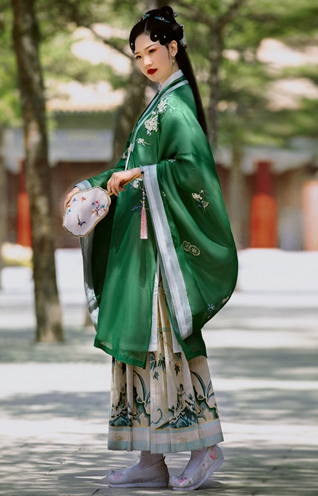
Social Media and Pop Culture Influence
The rise of social media and the influence of Chinese pop culture, particularly historical dramas, have also significantly contributed to Hanfu’s popularity. Shows depicting ancient Chinese stories and legends often feature beautiful, detailed Hanfu costumes that inspire viewers. Platforms like Weibo and TikTok (Douyin in China) have allowed Hanfu enthusiasts to share images, styling tips, and participate in Hanfu-themed events, further fueling its popularity.
Hanfu’s Role in Contemporary Chinese Identity
A Symbol of Identity and Pride
In contemporary China, Hanfu transcends its role as mere clothing; it has become a symbol of identity and cultural pride. Wearing Hanfu, especially for the younger generation, is a way to connect with and celebrate their heritage, something increasingly important in the rapidly modernizing and globalizing world. It offers a means of expressing Chinese aesthetics and philosophy in a tangible form.
Global Cultural Exchange
As China becomes more prominent on the global stage, Hanfu has also started to play a role in international cultural exchanges. It introduces aspects of Chinese culture to a global audience, showcasing the diversity and richness of Chinese traditions. This exchange fosters a deeper understanding and appreciation of Chinese culture worldwide, enhancing China’s soft power.
The revival and contemporary significance of Hanfu are multifaceted, encompassing aspects of cultural heritage, identity, modern fashion, and international cultural diplomacy. It represents a living tradition that continues to evolve while staying rooted in its historical and cultural origins.